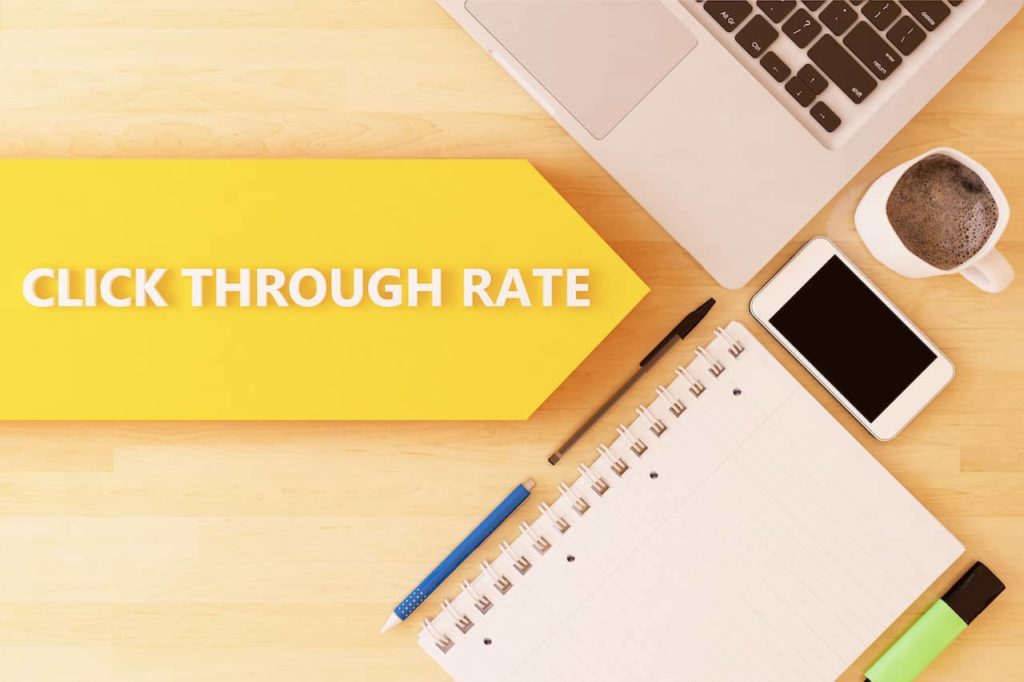As a business owner, your goal is likely to bring customers to your doorstep (virtual or not!) and grow your business. One such way you may achieve this is by creating an engaging and useful website for users. But how do you know if your website is actually helping your potential customers? That’s where click-through rate (CTR) comes in.
On any given page, you can analyze the CTR and understand how relevant your content is for users. Let’s start by defining what exactly a click-through rate is and discussing how you can increase yours.
What is SEO Click-Through Rate?
Your page’s SEO click-through rate is an essential metric. One that you won’t want to miss out on measuring. Put simply, your CTR is the percentage of users who clicked on your page from a search engine results page (SERP). This means that users felt your content was relevant to their search query.
Often, a high CTR in SEO means that your content is incredibly relevant to users. Lower click-through rates may be an indication that your content doesn’t match user search intent. If you notice a lower CTR, it could be time to re-evaluate your page.
Before you can understand whether your CTR is considered high vs. low for SEO, you’ll need to learn how to calculate a CTR. Keep reading to learn more about the formula used for CTR and what you can expect for your page.
Clicks, Impressions, CTR — Oh My!
So, how exactly is your page’s SERP CTR determined? Analytic platforms follow a specific equation to calculate your page’s click-through rate. This equation uses your page’s SEO clicks and impressions to ultimately generate your CTR percentage. Clicks refer to the number of users who have actually clicked on the link to your page on SERPs while impressions are the number of users who have simply seen your page on a SERP.
You can understand your CTR percentage using the following formula: Clicks/impressions = click-through rate
Once you’ve calculated your CTR, you can use this number to determine whether it is high or low compared to where it should be. Google offers a general average for pages based on their position on SERPs. Read on to learn more about what you can expect for your CTR based on your Google rankings.
Understanding Your Google Click-Through Rate By Position
In order to determine whether you have a high or low CTR, you’ll need to understand what the average CTR would be for your page. Google provides a general click-through rate using the position that your page sits on its SERPs. With this base number, you can figure out just how relevant your page is to users.
According to a recent study, pages that rank number one on Google are more likely to see higher SEO click-through rates. In fact, pages that hold the top spot on SERPs typically see a CTR of roughly 31.7%. By following SEO best practices, you can work to improve your SERP rankings and increase your CTR.
We’ve outlined a few of these best practices below to help you improve your rankings and see increased results.
Increasing Your SEO Click-Through Rate
The best part about SEO is that it offers plenty of opportunities for improvement! Increasing your CTR via SEO best practices is a useful tactic that can grow your website, and, therefore, your business. Begin your click-through rate journey with the following tips and tricks.
Analyze Current Content
The first step in improving your CTR through SEO is to understand where your content currently stands. Using a tool such as Google Analytics, you can run a report on your website that will generate your average CTRs. From there, you can see just where your content may be lacking and how you can optimize your pages for better results.
Distinguish Your Keywords
One reason your content may have a low click-through rate is due to your keywords being too general. While it’s important to go after keywords that are relevant to users, you may want to consider targeting additional keywords that can set your content apart from competitors. Spend some time sorting through keywords in tools such as Ahrefs’ Keyword Explorer and select keywords that have high search volume but lower keyword difficulty.
Additionally, don’t be afraid to go for long-tail keywords! Users may be typing more than a word or two into the search bar on Google. To match these queries, you can include long-tail keywords in your content. This will increase your chances of visibility on SERPs.
Engage From the Start
Your title holds more weight than you may realize. Creating an engaging but concise meta title is a great way to catch the attention of users and bring them to your page. On average, Google will show 50-60 characters for a title. Use these wisely — this is a major draw for users.
Don’t Forget Meta Descriptions
Before a user decides to click on your page, they may want an extra glimpse into what exactly they’ll be reading. Enter: meta descriptions. These are the 155-character-or-fewer snippets that briefly explain what your article is about. If you forget to input your own meta description, Google may write one for you. While this may sometimes help, it’s best to take the extra time and curate one that includes a main keyword and emphasizes why your page is worth the read.
Aim for Featured Snippets
Have you ever asked Google a question only to have the answer pop right up at the top of the page? If so, you’ve encountered a featured snippet. These are often short blurbs that answer a question quickly. Users will see these without ever having to scroll down the page. If your page is selected as the featured snippet, you’re likely to see an uptick in click-through rate as users may deem your website reliable.
Localize Yourself
Calling all small businesses — localization may be the way to go! If you have a physical location that you’re trying to bring customers to, targeting keywords such as “salon near me” may be just the way to increase your CTR and draw customers to your doorstep. You can use this localization tactic to increase your credibility with nearby customers.
Optimize for Web Core Vitals
Last but certainly not least, we have Google’s Web Core Vitals algorithm update! The purpose of this update was to encourage businesses to optimize their website and improve the user experience. By shifting your content and keeping up with these algorithm updates, you can ensure that your website has a chance at ranking. Remember what we said early about rankings? That’s right — the higher you rank, the more visibility your website will have and the higher you may see your CTR climb.
Interested in increasing your SEO click-through rates? Our expert team at Markitors can help you create relevant and engaging content, increase your domain authority, and keep track of your metrics as your website grows. Contact us today to learn more about our SEO services!







